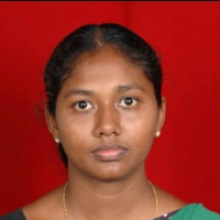
Marshiana Devaerakkam
Work place: Sathyabama Institute of Science and Technology, Chennai, Tamilnadu, India
E-mail: d.marshiana@gmail.com
Website:
Research Interests: Process Control System
Biography
Marshiana Devaerakkam born at Nagercoil, Tamilnadu, India on 25th November 1979. She graduated from Kalasalingam Engineering College with Bachlor’s Degree in Instrumentation and Control Engineering. Later she completed her post-graduation in Process Control and Instrumentation from Annamalai University. Currently she is pursuing her research at Sathyabama Institute of Science and Technology. Her research areas are Process control, controller design and soft computing techniques.
She is currently working as Assistant Professor and having teaching experience of 13 years. Her areas of interest include control system and process control, Soft computing techniques and control algorithms. She attended various workshops conducted by the industrials. She guided several student projects and she made research publications in diverse Journals and Conferences.
Author Articles
Impact of Equalizer Step Size in Underwater Acoustic Communication Channel
By Krishnamoorthy Raghavan Narasu Immanuel Rajkumar Jerry Alexander Marshiana Devaerakkam
DOI: https://doi.org/10.5815/ijcnis.2021.01.03, Pub. Date: 8 Feb. 2021
The Underwater Acoustic Channel (UAC) is a time variant channel and its multipath effects create ISI. This is one of the most important obstacles in the UAC channel which reduces the transmission rate. To remove this obstacle, a proper filter has to be designed in the receiver section. In this article, optimal step size for equalizer is computed and compared the results with the known techniques namely Decision Feedback Equalizer with interleave division multiple access (DFE IDMA) and Cyclic Prefix - Orthogonal Frequency Division Multiplexing (CP-OFDM) Equalizer. Channels are modeled using ray tracing methods. The various factors considered are ambient noise, attenuation loss, bottom and surface loss. The overall path loss for channels is computed by summing up the attenuation loss, surface and bottom loss. Simulation results evident that for short range UAC channel, the BER in the order of 10-2 is achieved using proposed methodology with least Eb/No compared to standard DFE method.
[...] Read more.Performance Analysis of Convolution Code with Variable Constraint Length in Shallow Underwater Acoustic Communication
By Krishnamoorthy Raghavan Narasu Suriyakala C D Ramadevi Rathinasabapathy Marshiana Devaerakkam Sujatha Kumaran
DOI: https://doi.org/10.5815/ijcnis.2019.02.02, Pub. Date: 8 Feb. 2019
One of the most complex environment for the data transmission is the underwater channel. It suffers frequency selective deep fading with serious multi path time delay. The channel also has limited bandwidth. In this paper, the effect of Least Code Weight – Minimum Hamming Distance (LCW-MHD) polynomial code is studied using Viterbi Decoding Algorithm for the shallow Underwater Acoustic Communication (UAC) channel. Two different channels with the range of 100 and 1000 meters are considered for simulation purpose and the channel is designed using Ray Tracing algorithm. For data and image transmission in the channel, three different code rate of 1/2, 1/3 and 1/4 are considered and corresponding Bit Error Rate (BER) are evaluated. Result showed that the BER is least for the LCG-MHD polynomial code.
[...] Read more.Other Articles
Subscribe to receive issue release notifications and newsletters from MECS Press journals